In my practice, I have met active mothers who drew up a development plan for their baby from his first days. They focused on hardening and water procedures, while pampering the baby with all the entertaining items, without thinking about what toys a 1-month-old child needs.
Trying to help their newborn become physically strong, some mothers forgot about something important - not only viruses can negatively affect the baby’s health, but also the household items around him. And a toy, as we all know, is the first thing that is often near a newborn and that he can put in his mouth.
I won’t intimidate you with all sorts of stories about cheap Chinese stamps, I’ll say it simpler: there should be few toys, they should be selected correctly and be as safe as possible for the baby.
How to choose the right quality toys
There is no difficulty in choosing safe play aids, just take into account the basic rules when purchasing and your baby will be happy and healthy.
Safe toys for a 1 month old baby:
- They do not have small parts or sharp corners;
- Solidly made, without the possibility of unscrewing or tearing something off (if it is a rattle made of several parts, pay attention to how well all the elements are fastened together);
- If the toy is rubber or plastic, it should not have an unpleasant or too sweet smell. Such a purchase can have a detrimental effect on the baby’s health;
- It’s worth giving up soft toys for now or playing with them with your newborn;
- It is better not to buy toys for your baby at the market or kiosk. Pick them up in the store, having first looked at the accompanying documents for the goods (sometimes illegal and dangerous children's products can even get into the store).
Important! Many parents buy rubber toys with squeaks for their baby. But not everyone knows that they need to be looked after properly.
Even if the purchased duck has passed all the tests, it can also cause harm to the baby. Over time, dirt mixed with water and baby saliva accumulates near the squeaker, and this is an ideal environment for bacteria. Wash such toys once a week in boiled water and soap, after removing the squeaker itself.
We play and develop. We select useful toys
To pick up the right toy baby, you need to take into account his gradual development. At the age of 1 month, the sucking and grasping reflex predominates in a newborn (learn about others >>>). At this age, the newborn gets used to new sounds and new tactile sensations. Therefore, useful educational toys for children from 1 month will be:
- Musical carousel (mobile);
- Not very loud rattles;
- Suspension for a stroller (crib);
- Developmental mat;
- 7 colored plastic balls (for playing, swimming and further studying colors).
A mobile is a unique toy by its nature. It has 2 functions: educational and entertaining. At the age of 1 month, the newborn learns to focus and concentrate his gaze on objects, and also learns to detect different sound frequencies.
At this age, a newborn should not buy overly complex musical toys; opt for a mobile phone with quiet, calm music, preferably classical. It’s not for nothing that they say that the classics have a good effect on the baby. With the classics, the baby easily calms down and quickly falls asleep.
If you decide to buy rattles for your baby, you can take several different ones, for example:
- a simple rattle with a handle;
- a rattle with several connected parts;
- and a book with a squeak and rustling pages.
The right rattle is the one that your baby will need for several months in a row and that the newborn will want to play with even at 2 years old.
Rubber toys have always attracted babies; in addition to the sound effect, which will not leave a newborn indifferent, rubber figures are very convenient for biting with the gums during teething. The main rule for mom: buy a toy that is not thin and odorless. Thin rubber can be bitten by a newborn over time, and the presence of an odor indicates a poor-quality rubber composition.
When buying a stroller suspension, you should also pay attention to the smell, as well as the structure of the parts. The figures should be smooth, without sharp, protruding corners, not very bright in color and odorless.
Now in stores you can find a huge number of educational mats, for every taste and for any newborn. I will highlight several options:
- Growing mat. This version of a developmental mat for a baby can be transformed over time. Such a toy will always delight a newborn. At first, you can raise the sides, thus creating additional protection for the baby, and over time, lower them and increase the area;
- Bag - mat. Easy to assemble and easy to disassemble. With such a rug you can often relax with your baby in nature. It doesn’t take up much space, but it brings so much joy to the newborn;
- Puzzle rug. Now you can buy floor puzzles of any size and color. Some rugs come with additional game elements (mini-puzzles), which over time are sure to captivate your baby with a new game.
Interesting! The safest toys in terms of composition are those made by mom.
On the Internet you can find a large number of handmade ideas, from rustling fabric cubes to baby sling beads. self made. And also, handmade toys are a memory for many years!
You can see what toys newborns will be interested in in the video:
Growing together with mom! A few ideas for the crafty mom
Sometimes mothers like making toys with their own hands more. If you don’t come up with anything, it doesn’t matter, there are the main common handmade options, all you have to do is add a little imagination and your newborn will have an exclusive one.
Handmade toys for a 1 month old baby:
- Developmental mat for newborns.
Take an unnecessary bedspread or duvet cover, sew patches of different textures, large buttons and various ribbons onto it. Place the blanket in the duvet cover and place it on the floor. Now you don’t need to worry about the newborn not rolling off - he will play on the rug, and the mother will be able to do household chores;
- Baby sling beads.
To create this educational toy, you can use round wooden blanks of different sizes. There are no blanks, use regular kinder surprises. The main thing is not to use glue, paints, varnishes or small parts when making a toy;
- Toy squeaker, rustle, rattle.
Take several types of scraps and sew a bag from each. Fill each bag with different cereals (buckwheat, rice, millet, peas, beans), add ringing elements and squeakers. Sew all the bags together - you have a caterpillar toy. Newborns love these toys very much.
Choose safe and interesting toys according to the age and needs of your baby!
Hello, dear readers of my blog! Psychologist Irina Ivanova is with you. I think that among you there are many parents with small children. I am sure that you know about the importance of play for the development of a preschool child. No other activity will introduce it gently and carefully into complex world surrounding reality, will not develop all possible abilities and skills.
You need to take care of the correct selection of toys for your baby from early childhood. Do you know what toys a child needs per year? So I recently had no idea about this until I had to choose a gift for my little niece.
![]()
About the most important thing
The most important principle of selecting toys for a one-year-old baby, as well as for a child of any age, is this. Which toy can be offered to a baby, and which one should be rejected, despite its benefits for the development of children?
Signs of a safe toy:
- It is made from natural materials: wood, natural fabric, as a last resort, from high-quality plastic.
- The toy smells pleasant or has no smell at all, there is no smell of dyes.
- It is impossible to cut, scratch, or hit on protruding parts and parts; there are no sharp corners.
- You should not buy toys for small children with small parts that they can choke on or put in places where putting them is dangerous to life and health. The baby is not yet a bit cautious; his parents must be prudent for him.
To form a real picture of the world, a child must see around him toys depicting animals, things and objects in in kind. Green men and pink dogs should not be purchased for little man, whose whole world is still limited by the walls of his apartment and the yard near the house. It is better if the toys are as realistic as possible to their originals.
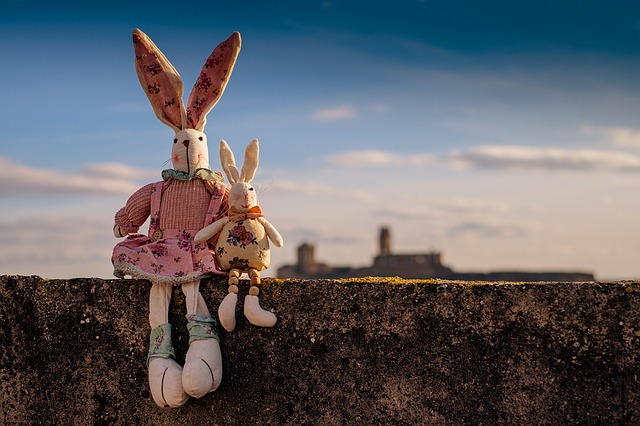
Development or entertainment?
It is difficult to say in advance which toys will be interesting to the baby. Often a colorful multifunctional module does not excite one year old child no interest, and regular or ball become the item of choice for many days and weeks. This often happens when parents think that their task is to provide the baby with toys, and he will figure out what to do with them.
This is a gross mistake - the capabilities of the toy must be revealed, shown how it is played or manipulated. At this stage, children cannot fully play without mom and dad, but they will learn to establish contact with peers by the age of 2-3.
The main tasks of development and education in 1 year, solved with the help of toys:
- Accumulation of a passive vocabulary (names of surrounding objects and phenomena);
- Development of large and fine motor skills, finger coordination;
- Enrichment of sensory concepts (concepts of color, sound, shape, volume, mass of objects).
- Emotional development baby.
There is no need to be afraid of difficulties; often the same toy solves several problems at once. The duty of an adult is to always be there, help and captivate the child. It is necessary to take into account the most important achievement of this age stage - the baby began to walk, his independence increased.
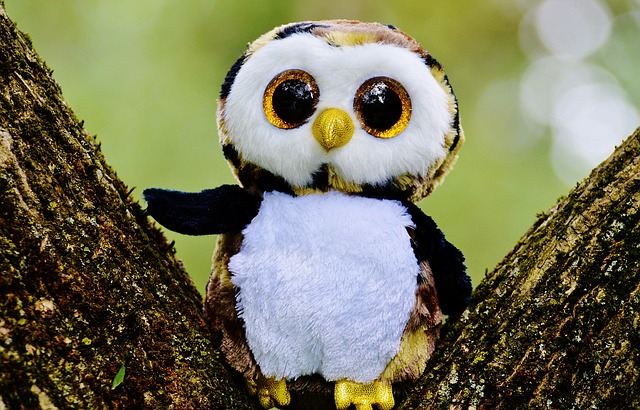
Toys useful for children aged 1 year:
- A pyramid with 4-5 rings is very interesting for children, develops motor skills, maybe with a hint base in the form of a cone; it is simply impossible to assemble such a toy incorrectly.
- Inserts made of 4-6-8 parts. They are often made of wood and represent three-dimensional figures, which you need to put into your recess. Develop attention and motor skills.
- Balls of different textures and sizes that can be thrown and pushed: rubber, textile, plastic.
- Lego-type constructors consisting of large parts.
- The cubes were soft at first (no matter how strange it may sound), a little later - wooden. All children love to build towers (and then break them with their own hands).
- Sorters (so-called “mailboxes”) and cup-type inserts - children really like to push various figures into the slots and holes. Round and square cups are so fun to nest inside each other!
- Gurneys, wheelbarrows, and ride-on cars develop precise movements and arouse interest in both boys and girls.
- Dolls, images of animals - this age is the countdown for the appearance of story game. The baby imitates the actions of its parents: feeds and puts dolls or bears to bed, rolls them in a stroller, “takes care of them.”
- Toys depicting dishes, vegetables, fruits and products for acting out various situations. Try giving your baby a set of tiny tools “like dad’s”; he will quickly find a use for them if mom and dad play with him.
- Clockwork, mechanized and musical toys for children's entertainment. Useful for establishing “cause-effect” connections: pressed a button - the toy moved, sang, jumped, swam.
To prevent precious time from going in vain, you need to give your child the “right” toys, play with him, and be responsible for creating a developmental environment.
I also recommend a program for activities with kids - " One year old school".
If you are interested in the topics discussed in the blog, I invite you to subscribe to updates and recommend articles to your friends. Goodbye, success and good luck!
Can a child's game be just fun? Child psychologist will immediately exclaim: “Under no circumstances! Without play, the full development of a child is impossible.”
Children's play is, in the full sense of the word, an exploratory activity. The baby thoroughly and seriously gets acquainted with the objects of the surrounding world - primarily with toys.
The choice of toys for a baby should not be left to chance. If a one-year-old person rattles a rattle all day long and does not know what cubes, pyramids, squeakers, etc. are, he will certainly lag behind his peers in development. Let's try to understand how to best organize a child's play space during the first year of his life.
Toys for newborns
Newborn from 0 to month toys are not required, since his entire life is determined solely by contacts with adults. But during the period from one to three months The child develops mechanisms of visual and auditory perception. So, at the age of one month, the baby not only fixes his gaze on the adult’s face, but also tries to follow him. At two months, the child is already interested in various objects, contrasting drawings, and patterns on wallpaper. Almost all the time, free from sleep and food, he looks at something, listens to something... Now is the time to provide the baby with comfortable material for examining and fixing his gaze. Let these be decorative spots of pure, bright color (light red, yellow, blue, bright green on a gray or cream background). These spots may represent geometric shapes or drawings pasted on the walls or ceiling. You can also hang colorful figures on strings from the ceiling. Note that children at this age most readily fix their gaze on yellow objects. Make sure that too many bright objects do not fall into the child’s field of vision - this will prevent him from focusing his vision on one spot (pattern) and getting a good look at it.
Coordination of eye movements is the next stage in the development of a child’s visual apparatus. Here he will be helped by special oculomotor gymnastics. Take a bright rattle and place it at a distance of 40 cm from the baby's eyes. After he fixes his gaze on it, move the toy to the right, then to the left, up, down... Watch the baby’s eyes. If he “lost” the rattle, repeat the exercise, just don’t overdo it: the lesson should last no more than two minutes.
It is useful to place a rattle in the baby's hand (of course, it should be light and not too bulky). The child cannot yet play with it, but gradually, as the motor system develops, he will begin to bring the toy to his face, then deliberately place it in his field of vision in order to see it better. And then the toy will begin to perform a formative function, stimulating targeted movements and developing eye-hand coordination.
Toys for a child from 3 to 6 months
During from 3 to 6 months the set of movements mastered by the child expands: he can, for example, not only reach a toy with his hand or foot, but also roll to it - in the literal sense of the word. This means it’s time to expand the play space - from time to time place the baby on the carpet or place him in a large playpen.
If previously the child learned about the world with the help of sight and hearing, now he tries to feel this or that object. At this stage, it is desirable that the toys available to him be varied in shape and texture. You can offer your baby not only plastic and rubber toys, but also soft ones (provided they are easy to clean). These toys sound very good - they stimulate meaningful movements like no other. If you hang a bell from the crib, the baby, by moving his arms or legs, can rock the crib and the bell will ring. He will like the sound and want to hear it again. Rattles that attach to the wrist like a bracelet also encourage the baby to move his arms.
Since at this time - from 3 to 6 months - the child’s arsenal of movements significantly expands, it’s time to update the range of toys available to him. Rubber squeaky animals, tumbler dolls and primitive musical instruments with large keys represent an inexhaustible source of interest for a 5-month-old baby - after all, they are “alive.” They talk, cry, laugh when he touches them (overturns them, presses them to himself, etc.).
Such simple activities with toys help to establish connections between the parts of the brain responsible for visual, auditory, tactile perception, as well as motor functions. The efforts that a child makes when trying to master a subject that interests him, and the difficulties associated with this, form one of the most important human abilities - to act purposefully and meaningfully. The behavior of a child with a toy in his hands is not yet a game, but a real, genuine exploration of both the object and the capabilities of his own body.
At this stage, it is very important not to overload the child’s attention - give him the opportunity to deal with one toy and only after that offer another. There is a point here: a child is most attracted to novelty, and to prevent a familiar toy from becoming boring, hide it from time to time. In a couple of days the baby will enjoy it like new.
Toys for a child 6-9 months
From 6 to 9 months The child’s motor capabilities are enriched and complicated. He moves freely on all fours and tries to stand up. At the same time, fine motor skills of the hands develop: the baby tries to grasp an object not only with his palm, but also with a pinch and fingers.
Previously, the child’s acquaintance with objects occurred as if by accident; now his actions are purposeful. Expanding the horizons of a little person largely depends on adults. It is a very serious matter to show a child how to handle various toys. How to spin the drum, how to press the keys with your fingers, how to make the ball roll. At this age, the child still tinkers with rattles and squeakers, but he is interested in more complex toys: cars, folding books with bright pictures(It is no coincidence that books made of thick cardboard are recommended for small readers, but full of fierce interest!).
This is a special time for parents: the expression “an eye and an eye” most accurately describes the situation. Many people try to restrain their child’s physical activity for safety reasons (or because they don’t have time to look after him). But the child should be protected only from what is truly dangerous for him. They learn from mistakes.
By 9 months The baby understands that you can play with two objects at once. For example, if you bang one toy against another, a sound appears (ringing, rumble), and he really likes it. Now he can finally figure out a set of molds, cubes and pyramids. At first, the baby will destroy the pyramids and castles made of cubes that you have assembled, but after some time he will definitely try to build something himself. For 7-9 month olds there are special construction toys made from flexible plastic. These are, as a rule, open rings that interlock remarkably easily (although for some reason children prefer to chew on them).
By this time, the child can play simple games with adults: “okay”, “peek-a-boo”, “shoo-oo, let’s fly”... Ask the child to point (find) this or that toy: “Where is the bunny?” If your child doesn’t understand you or finds it difficult to answer, help him: “Here he is, bunny!”
Toys for a 1 year old child
Greatest achievement in life one year old child- walking without support, that is, gaining a sense of balance. During this period (and even earlier, after 9 months), fine motor skills of the hands become more perfect day by day. If earlier child accidentally dropped toys, now he does it on purpose. A game arises, tiring for an adult, but endlessly attractive for a baby: he throws the elephant again and again, and the patient mother picks it up again and again.

The one-year-old already controls both hands: he puts the molds one into the other, strings pyramid rings onto the rod, undresses and puts on the nesting doll.
Everyone's favorite spinning top - just right for one-year-olds, as well as a metallophone and a drum. By mastering them, the child learns, among other things, to calculate the force of impact to produce a variety of sounds.
It is now that the child should be introduced to the huge world of an apartment or room, and household items. He needs to be shown how to handle water and dishes (unbreakable, of course). The sooner he begins to comprehend this side of home life, the safer his games will be.
A one-year-old child greatly enjoys toys such as a plastic telephone, sets of doll dishes, and a doll hair salon. This is all the more interesting to him because at this time he is playing like an ape with all his might - trying to copy adults. Mom combs her hair - and her daughter babbles, demanding a comb. And one more thing: at this age, children like to test everything for strength, so toys (any objects that the baby handles) should not break, much less break.
Since at this age the child is learning to control his body, he needs to play games that develop a sense of balance and coordination of movements. It is best to coordinate the movement of playing with a ball: a small ball can be thrown and caught, a large ball can be pushed with arms and legs, run after it, catch up with it and stop it. Butterflies impaled on a long stick are very good ( ladybugs, dragonflies) on wheels that the baby rolls in front of him.
Swings, jumpers, and a rocking horse are excellent objects for developing a sense of balance (of course, you can only swing on a horse with your mother - she will sit you down, shake you, and take you off).
Games with “waterfowl” toys - ducks, fish, etc. are extremely interesting for a child. And games in the sandbox have no equal at all: a one-year-old person can puff over molds for hours, pouring sand from one to another. At this time, he urgently needs his own bucket, scoop and dump truck. Baking Easter cakes from sand, that is, active and meaningful shaping, is a real act of creativity, one of the first steps towards the development of creative thinking.
By the way, one year old child You can already give him multi-colored pencils and paper, and when collecting him for the street, put crayons in his jacket pocket. When he realizes that these objects leave a mark, he will become keenly interested in the result of manipulating them. Children's scribbles are not at all what adults mean by this concept. This is the first attempt to identify and at least to a small (infantile) degree to understand the world. In addition, scribbling forms the coordination of the eye-hand system.
To summarize: in the first year of a child’s life, play and learning about the world around us can be safely equated. Later, the time will come for role-playing games, and then the child’s attitude towards toys will become different. But now living and playing are one and the same thing for him.
With the birth of a child, great happiness comes to the house, which also brings with it worries, anxieties, and worries. Young parents have so many questions! How to care for a baby, what should he buy first, what toys does a child need before one year old, how to choose them and when to start buying them? And this is just a small part of all the doubts that new mothers and fathers have. In this article we will try to tell you in as much detail as possible about what toys a newborn and an older child need.
From this article you will learn:
The role of toys in the lives of children
Some modern parents immediately after the birth of a child run to a children's store and buy everything there. As a result, the basket with toys ends up with teddy bears, dishes, rattles, cars and dolls. Others believe that the baby is not yet aware of anything happening around him and will not become interested in toys any time soon. Who is right? As always, friendship won: there is no need for excesses, but at the same time, completely deprive the child of necessary light industry products.
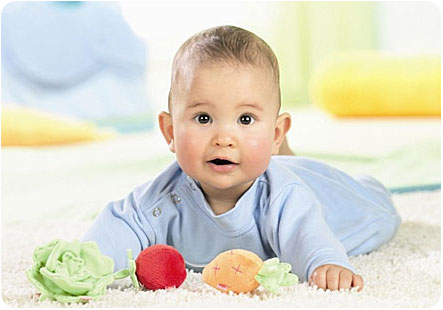
For children in the first months of life, toys are one of the main sources of information about the world around them. With their help, the child learns to see different colors, concentrate your attention. During the game, the baby’s consciousness and fine motor skills of the fingers develop. All of the above also affects the development of his speech, so toys are simply vital for the baby. But this does not mean that there should be so many of them that everything in the nursery will be occupied by them.
Toys by month for the little ones
1 month
Your child is still very young, but is already beginning to show interest in everything around him. Of course, at this age toys are bought more as a reserve than for playing with him. But nevertheless, you can do something for its development now. All the most pleasant moments of the baby’s life are currently associated with the mother and... with the diaper. Roll it up several times and hang it on the sides of the crib so that the child can look at it.
You can attach several contrasting pictures above the changing table. So, during hygiene procedures and dressing, the baby will learn to hold his gaze on an object.
2 month
Finally, you can begin to unpack the gifts that loving relatives presented to the child. Now is the time to use your mobile. It will actually become your baby's first toy. The musical carousel is usually attached above the baby's crib. Rattles that attach to the stroller can also be useful in the second month of a baby’s life. It is also good to have several small cubes with a black and white image. All these items will help the baby learn to concentrate and follow a moving object. 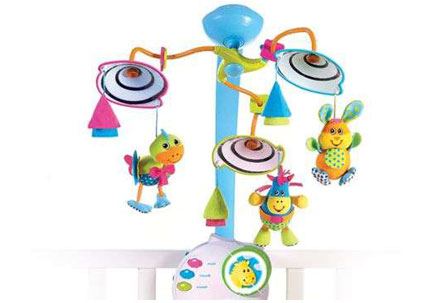
3 month
At this age, the child learns to grab the objects he likes with his hands. This also requires suitable toys: rattles, rubber or plastic rings and other products that can be held in the hand. You need different rattles: with a handle in the form of a stick, in the form of a ring or arc, or a triangle. Be sure to make sure that your child’s arsenal includes toys with different surfaces to the touch: “pimply”, ribbed, corrugated, etc.
Fabric toys will also become a great option for babies three months old. Soft animal figures, geometric shapes, rustling or ringing flowers can be attached to the arcs of a developmental rug, which you should also start using. 
4 month
At this age, the child learns or already knows how to roll over onto his tummy from his back and back. To make it interesting for him to be on his stomach, you need to attract his attention with something bright. Multi-colored balls, tumblers, rattles and various sounding toys will be very useful. During this period, you need to begin to develop the baby’s ability to sense the variety of their surfaces while touching objects.
To do this you need to stock up on toys from different materials, for example, from satin, fur, etc. It would be good to buy bright bracelets for the arms or special socks with bells, which are put on the arms so that the baby tries to reach with one hand with the other. 
5 month
We change the socks from the previous point onto the legs - let the baby try to reach the legs with his hands. This month you will need wooden, plastic or even rag cubes. They will help the baby strengthen his grasping skills, and small balls will influence fine motor skills hands It’s good if the child has a block with wooden cubes. The baby will be able to learn (with the help of his parents) to transfer an object from hand to hand. A teething ring is another one of the toys that a baby up to one year needs. 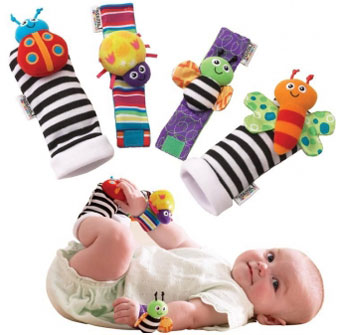
6 month
At this age, you can already invite your child to play musical instruments by purchasing a pipe or a bell. A musical toy will promote hearing development and encourage the baby to try to crawl towards the source of the sound. Usually at this age the child begins to sit up independently, which means that bathing in the bathtub will now be more of a playful activity than a hygienic one. 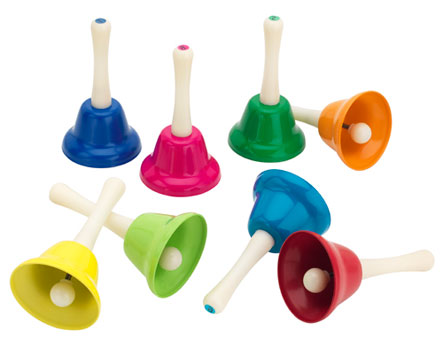
– an excellent way to make the water procedure exciting. You can also buy small books with pictures of animals or various objects. They can be rag, vinyl, cardboard or made of wood. Toys with mirror foil will help the baby begin to recognize himself in the reflection and he will look at the little one in the mirror with curiosity.
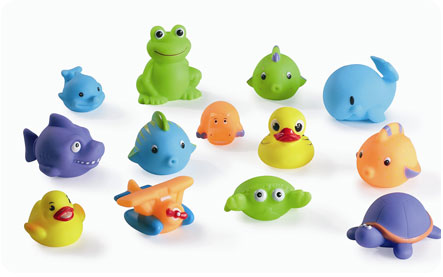
For children from six months to one year
From what toys a newborn will need, we move on to a more “adult” age group. Babies over six months old will be interested in the following toys:
- pyramids in the form of rings or cups of different sizes . A baby of 8-9 months can already be taught to put together a simple pyramid from several components;

- sensory toys , even self-sewn bags filled with cereals and peas will do. The baby crumples these bags with his fingers and develops motor skills;
- finger paints - This is a great idea for children's leisure. It is better to offer your child a large sheet of paper (you can even cut a piece from a roll of unnecessary wallpaper) and give him jars of paint. You just need to make sure that he doesn’t put his dirty hands in his mouth;
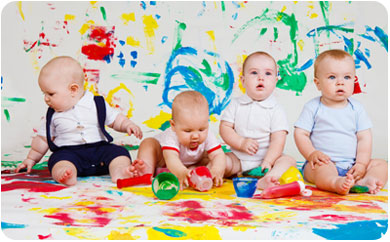
- insert toys. This is a collection of small items different shapes, which must be inserted into the corresponding holes in the frame or container;
- toys on wheels . It’s interesting to carry them in front of you when you once again crawl from mom to dad. These can be small cars, caterpillar tracks, trains, etc.;
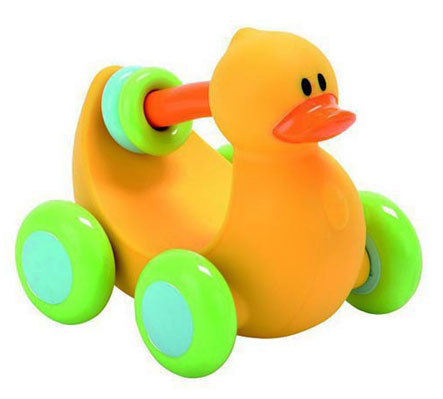
- gaming panels: telephones with buttons that, when pressed, will play music or animals will make sounds, a children's piano, etc.;
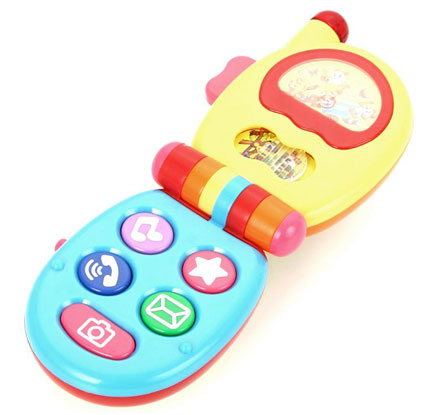
- cubes will also be needed, because the baby can already be taught to build towers from them, placing one object on top of another.
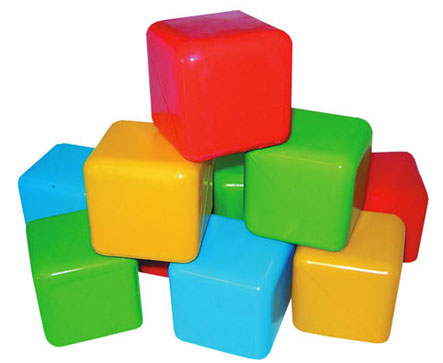
- dolls Even if a boy was born in your family, you will still need a doll for his development, even the simplest one. With its help, you can teach your baby to distinguish between different parts of the body and face: ears, nose, hands, etc.
Educational toys: what are they?
Educational toys for children under one year old should be functional, especially for children closer to 12 months. A child will be interested in a toy as long as he can do something with it, for example, twist its parts, pull levers, throw it, squeak with it, press buttons, etc.
Any such toy falls under the concept of developmental. It helps the child gain fundamental skills such as thinking logically, paying attention, and having good motor coordination.
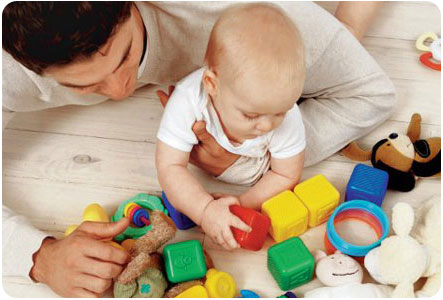
After six months motor activity the child increases many times. He not only crawls, but is already trying to stand on his legs, take his first steps, holding onto support. He can already grab toys not only with his whole palm, but also with his fingers.
His actions become purposeful, and not random, as before. And it is the parents who must teach the little one how to handle toys: how to spin a drum, roll a ball, press keys or squeak with a rubber elephant.
There should be several toy objects around the child at once; he will definitely find how to use them! Flexible construction sets and large mosaics are just a small part of what can be offered to a child as educational toys.
When a baby takes his first steps, he simply must have a rolling toy at hand. This could be an animal, a drum, or another figure on a stick that you can roll in front of you. It’s good if it rings, squeaks, rattles or makes other sounds. With it, the child will quickly master independent walking, because he will feel support.
Quality of toys for children under one year old
Having decided what toys newborns will need, we proceed to selecting each individual item. It is better, of course, to purchase all items at a specialized retail outlet and pay attention to the age limit indicated on the packaging or label. The inscription was made not for show, but to protect the baby from the possible danger of swallowing or in some other way harming himself with small parts.

The material of toys should be non-toxic and not have a characteristic chemical smell, because the child puts everything in his mouth. Fragile plastic or too fluffy fabric are also not for small children. The toy should not contain anything breakable. Small-diameter holes in which a child’s fingers can get stuck are also not welcome. That is, toys should be as useful as possible and absolutely safe!
And most importantly, pay more attention to your baby, then any toy will become educational and beneficial!
2016-11-16 13:08:43
Thanks for the article! I agree that toys should be of high quality and safe. As the first toy, we chose a Chicco teether in the shape of a butterfly; it has eyes and a kind smile, wings of different textures that are comfortable to hold. The baby plays with it for a long time, twirls it in his hands, looks at it, walks and scratches his teeth)) One wing is made of soft silicone. We really like such high-quality toys))
The development of a child’s emotional world is impossible without the existence of toys in it. It is toys that allow you to express your feelings, explore the world around us, teaches you to communicate and know yourself. Remember your favorite toys! These are not necessarily expensive huge lions and bears and electric cars and trains. For some, it’s a nondescript bear, a tiny doll.
Why does a child need a favorite toy?
Then, why do we, adults, need not only children, parents and work colleagues, but also friends and loved ones. A child should have a toy with which he can complain, which he can scold and punish, feel sorry for and comfort, which will help overcome loneliness when parents go somewhere, fear of the dark when the lights go out. As a friend, a child is more likely to choose a doll, a bear, a bunny, that is, a creature similar to a person, close and understandable to him.
Having learned about a child’s desire to have this or that toy, think about whether he really needs it.
The child should have a certain set of toys that promote development his perception, thinking, outlook, helping play out real and fairy-tale situations, imitate adults. You don’t have to buy some toys in a store; you can make them yourself, which will make them even closer and dearer to the child.
Real life toys
A doll family (this could be a family of animals), a dollhouse, furniture, dishes, a car, a railroad, a telephone and others.
Toys for releasing aggression
Toy soldiers, guns, balls, rubber toys, jump ropes, skittles and others.
Toys for developing creative imagination
Cubes, nesting dolls, pyramids, construction sets, alphabet books, board games, puzzles, mosaics, paints, plasticine, craft kits, etc.
Toys should be selected, not collected
Toys, as adults imagine them, are no good from a child’s point of view. It often happens that, having bought a toy for a child, our expectations are not met: the toy remains unclaimed. Why? Because we buy not for the child, but for ourselves, i.e. what we are interested in, what we would like to have in childhood.
Toys for the little ones must first of all develop the senses: ears, eyes, hands. They should be soft and warm, since the child has a need to feel warmth. The best toys for little ones are those that can be bitten. They should be made of safe materials, wash well, be lightweight, not have an elongated flat shape so that putting them in the mouth would prevent the child from choking, and bright.
For a one year old The baby will find pyramids of 3-4 rings, bowls that can be placed inside each other, and multi-colored cubes interesting and useful. Manipulating with these toys not only develops intelligence, but also brings pleasure and joy when the baby succeeds in something. Gurneys and tumblers are very useful.
For 2 year olds kids are very good at a large multi-colored ball that does not roll under the furniture, pyramids of 7-8 rings, soft toys. A large plastic car or box will teach you to be neat from this age, independence, since toys should be placed in them. Nowadays there is a huge selection of baskets and boxes for toys in stores. It’s good if the child has his own place for games and toys.
By three years the range of toys is expanding. TO bright toys simple construction sets are added that are assembled together with adults. Since at this age the child begins to actively engage in the world of real life situations, then sets of dishes, hairdressing supplies, Doctor Aibolit, furniture, etc. will be useful.
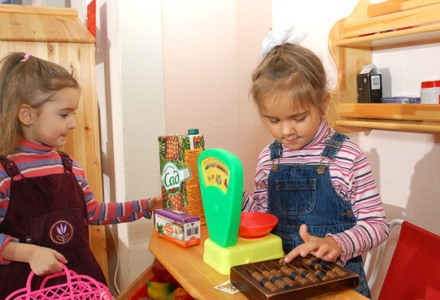
By the age of four Role-playing becomes the main activity. Many toys become unnecessary, since children's toys can turn a specific object into an imaginary one. Therefore, the greatest benefit will come not from purchased toys, but from those made with your own hands together with adults.
By age five large toys cease to interest the child. Animal sets, soldiers, and doll families attract more attention. There is a greater opportunity to play out different situations with the same toys, fantasy and imagination develop, thinking ceases to be specific, and the emotional world is enriched.
At 6 years of age I am no longer interested in static toys, but in various construction sets, assembling models, board games, handicrafts. Children really like handmade toys. Such toys make him happy and proud. Therefore, any desire of a child to make, sew, glue and give something to someone should be welcomed by parents if they want to develop in the child hard work, perseverance and the desire to do something in life for others.
In the future, the child himself makes an inventory of toys.
Don't force the child never throw away broken or outdated toys with his own hands, because these are his memories, these are his friends. It is better to repair them and give them to other children, kindergarten... By managing your child’s toy world yourself, you can throw away his most favorite toys.
From the book
Author Nadezhda Kryazheva
The site contains a fragment of the book intended exclusively for. You can purchase full version books from our partners.
|
N.L. Kryazheva “Development of the emotional world of children”
Buy at Labyrinth.ru Buy at Ozon.ru Buy at Ukraine Buy at Belarus Buy at Kazakhstan E-book |



